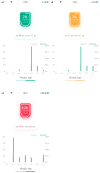Hearing Care: Safe Listening Method and System for Personal Listening Devices
- PMID: 36767527
- PMCID: PMC9915878
- DOI: 10.3390/ijerph20032161
Hearing Care: Safe Listening Method and System for Personal Listening Devices
Abstract
Excessive use of Personal Listening Devices (PLDs) and prolonged exposure to noise from loud music create many potential risks associated with hearing loss. To this end, the World Health Organization has published Recommendation ITU-T H.870 in 2019, which provides adults and children with a set of recommendations for sound dosage and operating times needed to avoid potential hearing risks. Some studies have investigated noise exposure of related applications for listening safety, resulting in some related recommendations and applications; however, these studies often do not pay attention to measurement error, which is important for human real noise exposure estimation to avoid hearing loss. This paper proposes a method for calculating noise exposure that can accurately calculate the actual noise sound-pressure level (SPL) and PLD dosage based on the WHO-ITU standard. We develop a calculation method and design a listening system that includes (i) a Safe Listening Personal Listening Device (SL-PLD) that can measure the listening dose in real time and control the output volume effectively, (ii) a Safe Listening Application (SL-APP) for assisting the SL-PLD to check the listening status in real time and provide alerts. Our experimental results show that (i) the proposed noise calculation method can reach 0.88 dB deviation under the 76 dB reference SPL and 98.8% accuracy, as compared to the SoundCheck tool measurement, (ii) the proposed SL-PLD controls the SPL output effectively as the dose increases, and (iii) the SL-APP determines the dosage usage and will provide a warning when the dosage exceeds a preset value. Therefore, users can adjust their listening behavior for more secure listening by using our methods and applications.
Keywords: dose calculation; hearing loose; safe listening APP; safe listening device.
Conflict of interest statement
The authors declare no conflict of interest.
Figures








Similar articles
-
Analysis of the Actual One-Month Usage of Portable Listening Devices in College Students.Int J Environ Res Public Health. 2021 Aug 13;18(16):8550. doi: 10.3390/ijerph18168550. Int J Environ Res Public Health. 2021. PMID: 34444299 Free PMC article.
-
Output capabilities of personal music players and assessment of preferred listening levels of test subjects: outlining recommendations for preventing music-induced hearing loss.Laryngoscope. 2012 Nov;122(11):2549-56. doi: 10.1002/lary.23596. Epub 2012 Oct 11. Laryngoscope. 2012. PMID: 23060148
-
Early Indication of Noise-Induced Hearing Loss in Young Adult Users of Personal Listening Devices.Ann Otol Rhinol Laryngol. 2018 Oct;127(10):703-709. doi: 10.1177/0003489418790284. Epub 2018 Jul 28. Ann Otol Rhinol Laryngol. 2018. PMID: 30056742
-
Targeting hearing health messages for users of personal listening devices.Am J Audiol. 2011 Jun;20(1):69-82. doi: 10.1044/1059-0889(2011/10-0039). Epub 2011 Apr 7. Am J Audiol. 2011. PMID: 21474557 Review.
-
Preventing Excessive Noise Exposure in Infants, Children, and Adolescents.Pediatrics. 2023 Nov 1;152(5):e2023063753. doi: 10.1542/peds.2023-063753. Pediatrics. 2023. PMID: 37864408 Review.
Cited by
-
Influence of music on the hearing and mental health of adolescents and countermeasures.Front Neurosci. 2023 Aug 3;17:1236638. doi: 10.3389/fnins.2023.1236638. eCollection 2023. Front Neurosci. 2023. PMID: 37600009 Free PMC article. Review.
-
"It's about wanting to disappear from the world… " - an interpretative phenomenological analysis on the meaning of music and hearing-related risks.Int J Qual Stud Health Well-being. 2025 Dec;20(1):2480966. doi: 10.1080/17482631.2025.2480966. Epub 2025 Mar 19. Int J Qual Stud Health Well-being. 2025. PMID: 40103436 Free PMC article.
-
Music as an Adjuvant Therapy in Postoperative Pain and Physiologic Parameters: Pre-Test, Post-Test Intervention Study.Rwanda J Med Health Sci. 2023 Nov 30;6(3):290-302. doi: 10.4314/rjmhs.v6i3.3. eCollection 2023 Nov. Rwanda J Med Health Sci. 2023. PMID: 40568645 Free PMC article.
References
-
- World Health Organization . Hearing Loss Due to Recreational Exposure to Loud Sounds: A Review. WHO; Geneva, Switzerland: 2015.
-
- Diviani N., Zanini C., Amann J., Chadha S., Cieza A., Rubinelli S. Awareness, attitudes, and beliefs about music-induced hearing loss: Towards the development of a health communication strategy to promote safe listening. Patient Educ. Couns. 2019;102:1506–1512. doi: 10.1016/j.pec.2019.03.013. - DOI - PubMed
Publication types
MeSH terms
LinkOut - more resources
Full Text Sources
Medical
Miscellaneous

